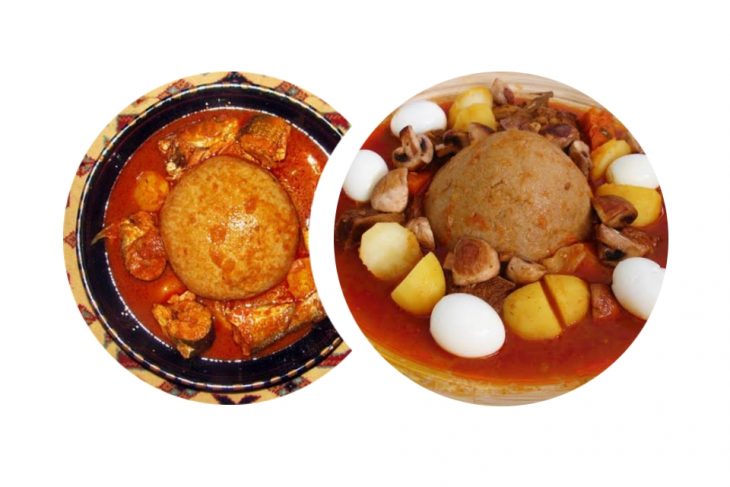
The various culinary arts of Africa use a combination of locally available fruits such as cereal grains and vegetables, as well as milk and meat products in the traditional way. In some parts of the African continent, the traditional diet features an abundance of milk, curd and whey products. Central Africa, East Africa, North Africa, Southern Africa and West Africa each have distinctive dishes, preparation techniques, and consumption methods. Indeed! A lot of African dishes are well spiced and properly garnished; not just for a mouth watering aroma and inviting presentation but also for a healthy and delicious meal. Africans don’t just eat; Africans eat healthy.

North Africa is found along the Mediterranean Sea and encompasses within its fold several nations, including Morocco , Algeria , Libya, Tunisia, Egypt and Sudan. The roots of North African culinary art can be traced back to the ancient empires of North Africa, particularly in Egypt, where many of the country’s dishes and culinary traditions date back to African ancient times. Over several centuries traders, travelers, invaders, migrants and immigrants all have influenced the culinary art of North Africa.
The 1st century Phoenicians brought sausages, while the Carthaginians introduced wheat and its by-product, (semolina). The Berbers adapted semolina into couscous, one of the main staple foods. Olives and olive oil were likewise introduced before the arrival of the Romans. From the 7th century onwards, the Arabs introduced a variety of spices, like saffron, nutmeg, cinnamon, ginger and cloves, which contributed and influenced the culinary culture of North Africa. The Ottoman Turks brought sweet pastries and other bakery products, and from the New World, North Africa got potatoes, tomatoes, zucchini and chili peppers.
It is also worthy of note that, most of the North African countries have several similar dishes, sometimes almost the same dish with a different name (the Moroccan tangia and the Tunisian coucha are both essentially the same dish, a meat stew prepared in an urn and cooked overnight in a public oven), sometimes with a slight change in ingredients and cooking style. To add to the confusion, two completely different dishes may also share the same name (for example, a “tajine” dish is a slow-cooked stew in Morocco, whereas the Tunisian “tajine” is a baked omelette / quiche -like dish). There are noticeable differences between the cooking styles of different nations, from the sophisticated, full-bodied flavors of Moroccan palace cookery to the fiery dishes of Tunisian cuisine and the humbler, simpler cuisines of Egypt and Algeria.
In the traditional South African culinary art, the cooking of Southern Africa is sometimes called “rainbow cuisine”, as the food in this region is a mixture of many cultures: indigenous African societies, European, and Asian. To understand indigenous African culinary art, it is important to understand the various native peoples of southern Africa. The indigenous Africans of Southern Africa were roughly divided into two groups and several subgroups. The largest group consisted of the Bantu-speakers, whose descendants today may identify themselves by various subgroup names such as Ndebele, Shona, Venda, Zulu, Xhosa, Swazi, Sotho, Tswana, Pedi, Shangaan and Tsonga. They arrived in the region around 2,000 years ago, bringing crop cultivation, animal husbandry, and iron toolmaking with them. Hence the Bantu-speakers grew grain crops extensively and raised cattle, sheep and goats. They also grew and continue to grow pumpkins, beans, and leafy greens as vegetables.

A smaller group were the primeval residents of the region, the Khoisan, who some archaeologists believe had lived in the region for at least 10,000 years. Many descendants of the Khoisan people have now been incorporated into the population of South Africa. The Khoisan originally were hunter-gatherers (who came to be known as “San” by the Bantu-speakers and as “bushmen” by Europeans). After the arrival of the Bantu-speakers, however, some Khoisan adopted the Bantu-speakers’ raising of cattle but did not grow crops. The Khoisan who raised cattle called themselves “Khoi-Khoi” and came to be known by Europeans as “Hottentots.” Interesting!
To some extent, people were defined by the kinds of food they ate. The Bantu-speakers ate dishes of grain, meat, milk and vegetables, as well as fermented grain and fermented milk products, while the Khoi-Khoi ate meat and milk, and the San hunted wild animals and gathered wild tubers and vegetables. In many ways, the daily food of native South African families can be traced to the indigenous foods that their native African ancestors ate. The Khoisan ate roasted meat, and they also dried meat for later use.

Good to mention, the influence of their diet is reflected in the universal Southern African love of barbecue (generally called in South Africa by its Afrikaans name, a “braai”) and biltong (dried preserved meat). The traditional beer was ubiquitous in the southern African diet, and the fermentation added additional nutrients to the diet. It was a traditional obligation for any family to be able to offer a visitor copious amounts of beer. Beer brewing was done by women, and the status of a housewife in pre-colonial southern Africa depended significantly on her skill at brewing delicious beer. Indeed, one of the very interesting facts about African traditional dishes is the affiliation of the peoples food with their origin.













